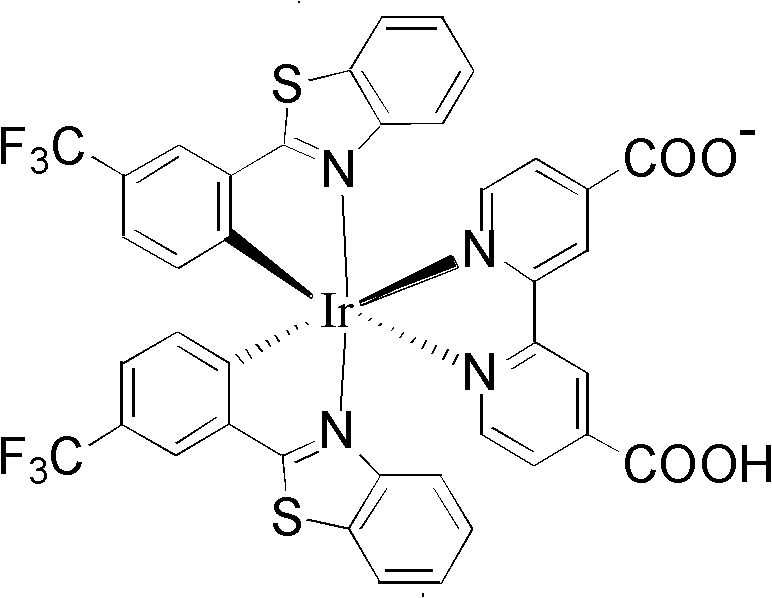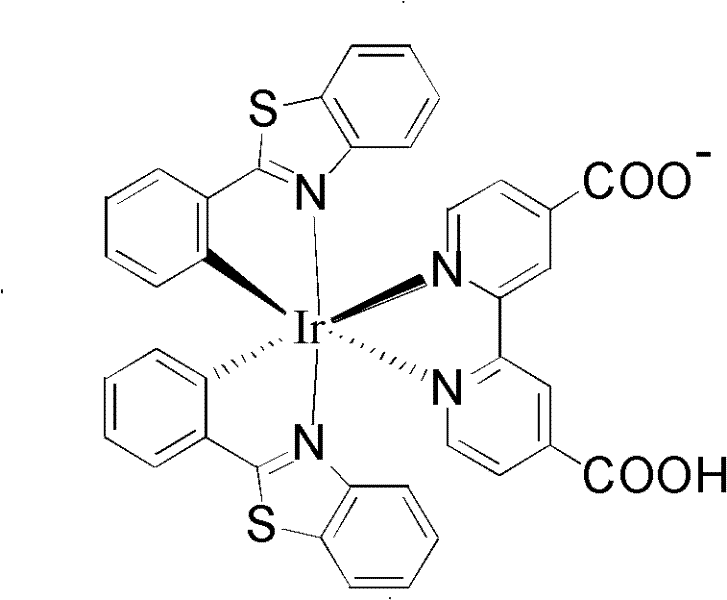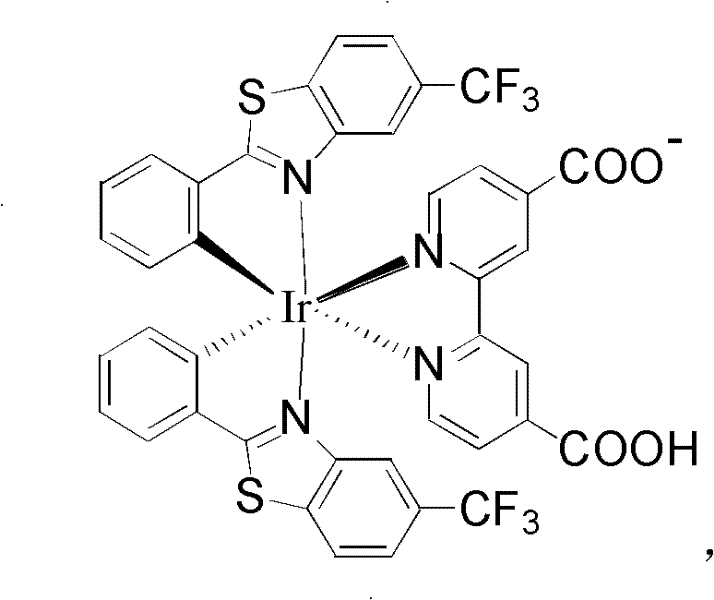Iridium complex, preparation method of iridium complex, method for catalyzing and reducing water by using visible light and dye-sensitized solar cell
A technology of iridium complexes and products, which is applied in the field of dye-sensitized solar cells, can solve the problems of poor absorption of visible light and slow catalytic rate, and achieve the effect of simplifying the reaction system and reducing costs
- Summary
- Abstract
- Description
- Claims
- Application Information
AI Technical Summary
Problems solved by technology
Method used
Image
Examples
Embodiment 1
[0022] Embodiment 1: the synthesis of iridium complex
[0023] Add iridium(III) chloride and ring metal ligand L to a mixed solvent of 24ml ethylene glycol ether and water (V / V, 3:1) in a molar ratio of 1:2, and then cool to At room temperature, after the solvent was spin-dried, the intermediate product was separated on a silica gel column with ethyl acetate and n-hexane ((V / V, 3:1) as the eluent, and the red stream was collected. After the solvent was spin-dried, the intermediate product was obtained by drying. Product Ir 2 (L) 4 Cl 2 . With binuclear intermediate product and 4,-4'-dicarboxylic acid-2,2'-bipyridine, sodium carbonate is added in the second solvent in the ratio of 1:1.2:8 (for complex 1-3, the second Solvent is in the mixed solvent of methanol and dichloromethane (V / V, 1: 1), for complex 4, the second solvent is ethylene glycol ether solution), reflux reaction 24h under nitrogen protection, cool to room temperature, with The mixed solvent (V / V, 1:1) of met...
Embodiment 2
[0029] Photocatalytic reduction of water by iridium complexes in a homogeneous catalytic system to produce hydrogen: Add 2.7 μmol of iridium complexes to a mixture containing 0.28M triethanolamine, 0.02mM K 2 PtCl 4 , in a neutral aqueous solution of 0.135M LiCl (270ml), after the air in the reactor was pumped dry, it was irradiated under a 300W xenon lamp (λ>420nm), and the hydrogen gas generated by the reaction was quantitatively analyzed by gas chromatography. The systems in which complexes 1, 2, 3, and 4 are located produced 2027 μmol, 175 μmol, 55 μmol, and 9 μmol of hydrogen after 20 h of light irradiation, and the hydrogen evolution efficiency of complex 1 is the highest reported in aqueous solution.
Embodiment 3
[0031] Preparation of hydrogen by photocatalytic reduction of water with iridium complex-sensitized titanium dioxide in a heterogeneous system: place titanium dioxide in a methanol solution saturated with the complex, stir in the dark for 24 hours, filter out the sensitized titanium dioxide in solid state, and dry to obtain powder sample. Add 0.1 g of iridium complex-sensitized titanium dioxide solid (the amounts of iridium complexes in complexes 1, 2, 3, and 4 are 2.17 μmol, 3.01 μmol, 2.56 μmol, and 3.34 μmol, respectively) to a solution containing 0.28 M Triethanolamine, 0.02mM K 2 PtCl 4 , in a neutral aqueous solution of 0.135M LiCl (270ml), after the air in the reactor was pumped dry, it was irradiated under a 300W xenon lamp (λ>420nm), and the hydrogen gas generated was quantitatively analyzed by gas chromatography. The amount of hydrogen generated by complexes 1, 2, 3, and 4 after 20 h of light irradiation was 1253 μmol, 403 μmol, 131 μmol, and 512 μmol, respectively...
PUM
 Login to View More
Login to View More Abstract
Description
Claims
Application Information
 Login to View More
Login to View More - R&D
- Intellectual Property
- Life Sciences
- Materials
- Tech Scout
- Unparalleled Data Quality
- Higher Quality Content
- 60% Fewer Hallucinations
Browse by: Latest US Patents, China's latest patents, Technical Efficacy Thesaurus, Application Domain, Technology Topic, Popular Technical Reports.
© 2025 PatSnap. All rights reserved.Legal|Privacy policy|Modern Slavery Act Transparency Statement|Sitemap|About US| Contact US: help@patsnap.com



